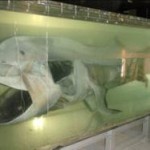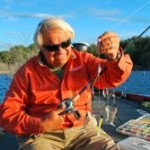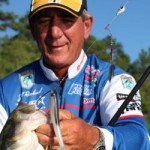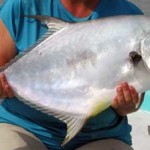The Megamouth Shark Specialist: Dr. Jose Castro Discusses his Rare Expertise
Dr. Jose Castro. Photo Credit: Mote Marine Laboratory Dr. Castro (L) and his Japanese colleagues pose in front of the Megamouth shark specimen Photo Credit: Okinawa Charaumi Aquarium Left side of megamouth shark Left side of megamouth shark showing organs and cartilaginous skeleton Photo Credit: Okinawa Charaumi AquariumMegamouth sharks are one of the most elusive shark species in the world. Since their discovery in 1976, megamouths have been documented between 50 and 60 times; yet only a handful of specimens are on diplay at aquariums. Exceeded in size only by whale sharks and basking sharks, the large megamouth shark uses its wide jaws to filter for plankton in the deep-sea. Recently, biologist Dr. Jose Castro of NOAA Fisheries had a unique opportunity to help dissect a rare megamouth shark on display at the Okinawa Churaumi Aquarium in Japan.
They don’t call Castro a specialist for nothing. In 1994 he was part of the first ever female megamouth shark dissection at Fukuokka, Japan, and has dissected the only specimen caught in the Atlantic. We met with Castro to ask about the recent dissection and to learn more about the elusive megamouth.
How did you first get involved with megamouth shark research and dissections?
In 1994, a female megamouth was stranded in Fukuokka, Japan, and I was invited by Senzo Uchida of the Okinawa Churaumi Aquarium, to help with the dissection. Everyone was particularly excited that the shark was a female because we had the opportunity to investigate reproduction questions. For years that was the only dissection of a megamouth, and to this day the majority of information known about the species comes from that one shark. Later, the Brazilians invited me to document a megamouth caught off the coast of Brazil. Of course there are more megamouths in the Atlantic, but just one confirmed specimen has been found there.
What is it like dissecting a megamouth shark?
I dissect big animals all the time. But when I was working in Japan with the dissection team led by Dr. Keiichi Sato, it was a different and fantastic experience. We were not just examining the megamouth, we were preparing an exhibit for the aquarium. On one side of the creature we removed the muscle to expose the organs and skeleton, which was made of cartilage and connective issue. Visitors could actually see the animal’s anatomy. The dissection was a difficult and time-consuming process, and it didn’t help that the animal was preserved before we started, so the smell was horrible.
What do you hope people will learn from the megamouth display at the Okinawa Churami Aquarium?
The Okinawa Aquarium is one of the greatest in the world. The previous director, Senzo Uchida, was the first person to successfully keep whale sharks and manta rays in captivity. The research and curiosity behind the scenes give the public a chance to see what these creatures are really like. The megamouth specimen will be a part of a very unique filter-feeder exhibit along with the head of a 27-foot basking shark. I hope this will spark interest in the visitors the way it has for the scientists.
How does your work make a difference in shark management?
We have done a good job managing shark fisheries in this country, but not on an international scale. Sharks are among the last group of large vertebrates being destroyed by humans, and it has taken us a long time to realize we need new methods. Shark finning and other practices threaten the future of sharks, and we need international cooperation to make a difference. Luckily, the pursuit of science bridges countries and connects people to our oceans.
What is the one thing you want the public to know about megamouth sharks?
We hardly know anything about this shark. Through tagging we know that it goes up and down in different depths at night, but tags cannot tell us the bigger picture of what the shark is doing and why. The most we have learned about these creatures is through necropsies, or looking at them after they’ve died. We have yet to discover everything about these mystifying creatures: their behavior, reproduction, physiology, and some anatomical features. The first one was discovered in 1976, but didn’t become known outside the science community until 1983. I think the megamouth shark shows how little we know about the oceans. A lot remains to be discovered, even about these large animals.





